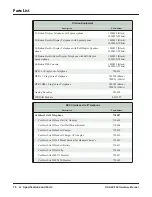
3
HCD-RG121
TABLE OF CONTENTS
1.
SERVICE POSITION
...............................................
4
2.
GENERAL
...................................................................
6
3.
DISASSEMBLY
3-1.
Cover (Top) ...........................................................
9
3-2.
CD Door ................................................................
9
3-3.
Front Panel Section ............................................... 10
3-4.
CD Mechanism Deck (CDM74-K6BD80) ............ 10
3-5.
Tape Mechanism Deck, GAME JACK Board ....... 11
3-6.
PANEL Board ........................................................ 11
3-7.
Back Panel Section, SUB-TRANS Board ............. 12
3-8.
Power Transformer ................................................ 12
3-9.
MAIN Board ......................................................... 13
3-10. AMP Board ........................................................... 13
3-11. BD80A Board ........................................................ 14
3-12. CONNECT Board ................................................. 14
3-13. DRIVER Board, SW Board .................................. 15
3-14. Optical PICK-UP (KSM-213DCP/Z-NP) ............. 15
3-15. SENSOR Board ..................................................... 16
3-16. MOTOR (TB) Board ............................................. 16
3-17. MOTOR (LD) Board ............................................. 17
4.
TEST MODE
............................................................... 18
5.
DIAGRAMS
5-1.
Block Diagram – PANEL Section – ...................... 22
5-2.
Block Diagrams – MAIN Section – ...................... 23
5-3.
Block Diagrams – BD/DRIVER Section – ........... 24
5-4.
Printed Wiring Board – BD80A Section – ............ 25
5-5.
Schematic Diagram – BD80A Section – ............... 26
5-6.
Printed Wiring Board
– CD MECHANISM Section – ............................. 27
5-7.
Schematic Diagram
– CD MECHANISM Section – ............................. 28
5-8.
Printed Wiring Board – MAIN Section – .............. 29
5-9.
Schematic Diagram – MAIN Section (1/2) – ........ 30
5-10. Schematic Diagram – MAIN Section (2/2) – ........ 31
5-11. Printed Wiring Board
– PANEL COMB Section – ................................... 32
5-12. Schematic Diagram
– PANEL COMB Section – ................................... 33
5-13. Printed Wiring Board – PANEL Section – ............ 34
5-14. Schematic – PANEL Section (1/2) – ..................... 35
5-15. Schematic – PANEL Section (2/2) – ..................... 36
5-16. Printed Wiring Board – TRANS Section – ........... 37
5-17. Printed Wiring Board – AMP Section – ................ 38
5-18. Schematic Diagram – AMP POWER Section – .... 39
5-19. IC Pin Function Description .................................. 42
6.
EXPLODED VIEWS
6-1.
MAIN Section ....................................................... 48
6-2.
Front Panel Section ............................................... 49
6-3.
MAIN Board Section ............................................ 50
6-4.
CD Mechanism Deck Section-1
(CDM74-K6BD80) ............................................... 51
6-5.
CD Mechanism Deck Section-2
(CDM74-K6BD80) ............................................... 52
7.
ELECTRICAL PARTS LIST
.................................. 53
Unleaded solder
Boards requiring use of unleaded solder are printed with the lead-
free mark (LF) indicating the solder contains no lead.
(Caution: Some printed circuit boards may not come printed with
the lead free mark due to their particular size.)
: LEAD FREE MARK
Unleaded solder has the following characteristics.
•
Unleaded solder melts at a temperature about 40°C higher than
ordinary solder.
Ordinary soldering irons can be used but the iron tip has to be
applied to the solder joint for a slightly longer time.
Soldering irons using a temperature regulator should be set to
about 350°C.
Caution: The printed pattern (copper foil) may peel away if the
heated tip is applied for too long, so be careful!
•
Strong viscosity
Unleaded solder is more viscous (sticky, less prone to flow) than
ordinary solder so use caution not to let solder bridges occur
such as on IC pins, etc.
•
Usable with ordinary solder
It is best to use only unleaded solder but unleaded solder may
also be added to ordinary solder.
Summary of Contents for HCD-RG121
Page 65: ...65 HCD RG121 MEMO ...




































